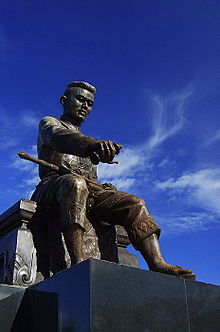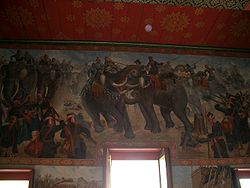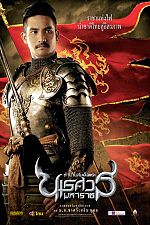- Naresuan
-
Naresuan The Great
สมเด็จพระนเรศวรมหาราชKing of Ayutthaya 
Royal statue of King Naresuan at Naresuan university, Phitsanulok province, Thailand King of Siam Reign 29 July 1590 – 25 April 1605 Predecessor Maha Thammaracha (Sanphet I) Ekathotsarot (Sanphet III) House Sukhothai dynasty Father Maha Thammaracha (Sanphet I) Mother Wisutkasat Born 25 April 1555
Chan Palace, Phitsanulok, ThailandDied 7 April 1605 (aged 49)
Haeng, ThailandSomdet Phra Naresuan Maharat (Thai: สมเด็จพระนเรศวรมหาราช) or Somdet Phra Sanphet II (Thai: สมเด็จพระสรรเพชญ์ที่ 2) (1555, 25 April – 1605) was the King of the Ayutthaya kingdom from 1590 until his death in 1605. Naresuan was one of Siam's most revered monarchs as he was known for his campaigns to free Siam from Burmese rule. During his reign numerous wars were fought against Burma, and Siam reached its greatest territorial extent and influence.
Contents
Early life
Prince Naret was born in the city of Phitsanulok on the 25 April 1555. He was the son of King Maha Thammarachathirat of Phitsanulok and his queen Wisutkasat. His mother was a daughter of Maha Chakkrapat and Queen Sri Suriyothai. His father was a Sukhothai noble, who had defeated Vorawongsathirat in 1548 and put Maha Chakkrapat on the throne. He was therefore an influential figure.
Prince Naret was also known as the Black Prince (Thai: พระองค์ดำ) to distinguish him from his siblings. His younger brother Ekathotsarot was known as the White Prince, and his elder sister Suphankanlaya was known as the Golden Princess.
In 1563 Bayinnaung, the King of Pegu, led massive Burmese armies in an invasion of Siam. King Bayinnuang laid siege to Phitsanulok. Maha Thammarachathirat came to believe that the city would not be able to withstand a long siege, so he surrendered to the Burmese. King Bayinnuang took Phitsanulok and made the Kingdom of Sukhothai a Burmese tributary. Maha Thammarachathirat had to send his sons – the Black and the White Prince – to Pegu as captives to ensure the king's fidelity.
At Pegu
Naret, along with other captive princes from other kingdoms, were educated in martial arts and war strategy of Burmese and Portuguese style. He was later noted for his new tactics that enabled him to gain victory over the Burmese. Naret then found himself under competition with Bayinnuang's grandson (Nanda Bayin's son) Minchit Sra.
In 1569, Bayinnuang was able to take Ayutthaya and installed Maha Thammarachathirat as the King of Ayutthaya. After seven years of captivity, Prince Naret, along with his brother the White Prince, was released to Ayutthaya in exchange for his sister Supankanlaya as Bayinnuang's concubine.
King of Sukhothai
Phitsanulok History
This box contains links to selected
articles with information related
to the history of Phitsanulok Province.Prehistoric Era Khmer Empire Singhanavati City-State Sukhothai Period Wat Chula Manee · Wat Aranyik
Wat Chedi Yod Thong
Wat Phra Sri Rattana MahathatAyutthaya Period Boromma Trailokanat
Wat Ratchaburana · Wat Nang Phaya
Boromma Racha III · Naresuan
Boromma KotModern Siam / Thailand Maha Thammarachathirat made Naret the Uparaja and King of Phitsanulok as Naresuan in 1569, aged 14. In 1574, Naresuan joined his father in the expedition to conquer Vientiane but he suffered smallpox.
In 1581, Bayinnuang died, to be succeeded by his son Nanda Bayin. In 1583, Nanda Bayin's uncle who was the Lord of Innwa rebelled against his newphew at Pegu. Nanda Bayin then requested for Siamese troops and supports against Innwa. Naresuan marched the Siamese armies to Innwa but slowly to leave the rebellion defeated before he would reach Innwa or else the Lord of Innwa would get Nanda Bayin.
However, this raised Nanda Bayin's suspicions about Naresuan's loyalty. Nanda Bayin then secretly ordered his son Minchit Sra to defeat Naresuan's army and kill him upon reaching Pegu and ordered Kiet and Ram – the two Mons of the city of Kraeng on the Sittoung River – to attack Naresuan on the rear after he had passed Kraeng while Minchit Sra would attack the front.
Naresuan reached Kraeng in 1584. However, Ram and Kiet were Naresuan's childhood acquintances, so they informed Naresuan about Nanda Bayin's plans. Naresuan, upon realising the intentions of Nanda Bayin, performed a ceremony to denounce Burmese tributary, saying;
All the holy deities with universal knowledge, the King of Hanthawaddi doesn't embrace the fidelity as the kings should do but is indeed intended to hurt me. From now on, the alliance of Ayutthaya and Hanthawaddi breaks, forever.Naresuan then levied the Mons to join his campaigns under the leadership of Kiet and Ram and then marched to Pegu. However, Nanda Bayin had already defeated the Lord of Innwa and was marching back to Pegu. Naresuan decided to retreat but Minchit Sra himself led the Peguan army to follow Naresuan. The Burmese caught the Siamese at Sittoung River, culminating the Battle of Sittoung River. The legend says that Naresuan shot a fire at a Burmese general accurately across the Sittoung River – called the Royal Shot Across the Sittoung River (Thai: พระแสงปืนข้ามแม่น้ำสะโตง). After the death of his general, Minchit Sra retreated.
In 1583, Naresuan ordered all northern cities including Phitsanulok to be evacuated as it would became the warfronts between Ayutthaya and Pegu. So, Phitsanulok ceased to be the seat of Sukhothai kingdom and Naresuan became, therefore, the last king of Sukhothai.
Main article: Burmese-Siamese War (1584 - 86)In the same year Nanda Bayin ordered his uncle the Lord of Pathein and Noratra Mangsosri the Burmese King of Lanna to lead the Burmese armies into Siam but was defeated by the Siamese. In 1586, Nanda Bayin himself led the Burmese armies to Ayutthaya and laid siege on the city for 13 months and failed. In 1590, Maha Thammarachathirat died. Naresuan was crowned as the King of Ayutthaya as Sanphet II.
Reign as King of Ayutthaya
Main article: Burmese-Siamese War (1590 - 92)King Naresuan made his brother the White Prince the Uparaja with equal honor as Naresuan himself. In 1590, Minchit Sra marched into Siam through Chedi Sam Ong. Instead of taking defensives at Ayutthaya, Naresuan chose to march to Chedi Sam Ong. Minchit Sra, thinking that the Siamese would stay at Ayutthaya for defensive, marched unprepared. The Burmese were persuaded into a field and ambushed by Naresuan's armies. With his armies scatttered, Minchit Sra retreated back to Pegu.
Yuddhahatthi
Main articles: Battle of Nong Sarai and YuddhahatthiIn 1592, Nanda Bayin ordered his son to attack Ayutthaya again. Minchit Sra, along with the Lord of Pyay, Natshinnaung the son of the Lord of Toungoo, and the Burmese King of Lanna, led the Burmese into Siam. Minchit Sra himself went through Chedi Sam Ong peacefully and reached Suphanburi, while other came from the north. Naresuan was planning to conquer Cambodia, but then he had to change his intentions. Naresuan encamped his armies at Nong Sarai. The Burmese then arrived, leading to the Battle of Nong Sarai.
During the battle, the elephants of Naresuan and Ekathotsarot went mad and ran into the midst of the Burmese. Siamese Chronicles stated that there were fake Minchit Sras but Naresuan pointed out the real one from the honorary decorations. Naresuan then urged Minchit Sra to fight with him:
My brother, why do you hide yourself in the canopy shadows? Let us fight the elephant battle for our own honors. No future kings will do what we are going to do.The personal battle between Naresuan and Minchit Sra was a highly-romanticized historical scene known as Yuddhahatthi, the Elephant battle. After narrowly missing Naresuan and cutting his hat (on display in Bangkok) Minchit Sra was slashed to death on the back of his elephant. This was on Monday, the 2nd waning day of the 2nd month of the Buddhist calendar Chulasakarat Era year 954. Calculated to correspond to Monday, 18 January, AD 1593 of the Gregorian calendar, this date is now observed as Royal Thai Armed Forces day. Naresuan then built a pagoda on the site of Yutthahadhi as a victory monument. However, modern historians are still unable to locate the pagoda.
Naresuan intended to execute all the soldiers in the battle of Nong Sarai who had provided no support to him and his brother. Somdet Phra Wannarat – a bhikkhu – calmed Naresuan to get him to lift the punishment. Naresuan then instead ordered them to take Tavoy and Tenasserim.
Tavoy and Tenasserim
In 1593, Naresuan sent Siamese forces to lay siege on Tavoy – a Mon city – by the Minister of Kromma Tha and Tenasserim and Mergui by the Samuha Kalahom , all quickly fell. Nanda Bayin launched Burmese fleets to recapture the cities. The Samuha Kalahom then seized the galleons at Mergui to construct a fleet and sailed and marched his armies on land to counter Burmese attack from Martaban. The Siamese were then able to repel the Burmese.
Capture of Lovek
Main article: Siamese invasion of Cambodia (1593 - 94)After Yuttahadhi, Naresuan then launched his campaigns to subjugate Cambodia. He sent four armies to capture Champasak, Banteymas (modern Ha Tien in Vietnam), Siem Reap, and Naresuan himself Battambang – all to be joined at Lovek. In 1594, they all reached Lovek and looted Lovek to the grounds. King Borommaracha V fled to Vientiene. Naresuan took Borommaracha's brother Sri Suriyopor as captive and took his daughter as his concubine.
Naresuan left a Siamese army at Oudong to oversee Cambodia, only to be driven out by Rama Chungprey in 1595.
Capture of Martaban
As Burmese control over the tributaries had weakened, the Mons took this opportunity to free themselves. The Mon governor of Moulmein rebelled against Pegu and requested Siamese support. Naresuan sent troops to take the Mon city of Martaban that sided with Pegu. Nanda Bayin sent the Lord of Toungoo to Martaban but was repelled and retreated. Capture of Martaban exerted Siamese control over the Mon state.[2]
Invasion of Pegu
Main article: Siege of Pegu (1595)Naresuan eventually marched his troops to Pegu in 1595. He laid siege on the city for three months but was unable to enter. The huge forces of the Lords of Pyay, Toungoo, and Ava then arrived to free Pegu. Naresuan decided to retreat.
Main article: Burmese-Siamese War (1599 - 1600)The Lord of Pyay staged a rebellion against Nanda Bayin in 1595, followed by Toungoo, Rakhine, Lanna, and Lan Xang. King Nokeo of Lan Xang prepared to march through Lanna to Pegu to rescue the Laotian captives. Noratra Mangsosri of Lanna (Nanda Bayin's brother) then put his kingdom under Siamese tributary to get Ayutthayan supports. Naresuan sent Siamese forces to prevent Laotian forces from entering Lanna.
After the series of upheavals in the Burmese Empire, Naresuan decided to invade Pegu again in 1599. Naresuan allied himself with Rakhine. However, the Lord of Toungoo feared that if Naresuan had taken Pegu the Siamese power would have been too large and might engulf Toungoo itself. So, the Lord of Toungoo encouraged the Mons to rebel against Siam. Naresuan then had to subjugate the Mon rebellions.
Toungoo finally took Pegu the same year with the help of Rakhine. Toungoo took Nanda Bayin and left for Toungoo. When Naresuan reached Pegu, what he found was only the city ruins. He requested Toungoo to sent Nanda Bayin back to him but Toungoo refused.
Invasion of Toungoo and Lanna
Naresuan laid the siege on Toungoo but readily failed. Naresuan then went back. He sent his brother Ekathotsarot to calm Lanna inner conflicts.
As in 1600, the Kingdom of Ayutthaya reached the greatest extent.
Death
Anaukpetlun crowned himself as the King of Ava to counter Toungoo and went on his campaigns to subjugate the Shans. However, the Shan King of Hsenwi was Naresuan's childhood friend. So, he marched armies to rescue Hsenwi. During his journey, however, Naresuan died in 1605.
Recent studies of Burmese records by historians of Silpakorn University showed that he returned to Wiang Haeng, where he died of disease, probably smallpox.
His brother King Ekathotsarot became his successor as king.
According to the Shan, King Naresuan helped them win independence for the Shan State in 1600 with his ally, the Prince of Hsenwi. Both had been hostages at the Burmese court, and King Naresuan died while rushing to the aid of a friend of his youth, they say.
Many Shan believe King Naresuan was cremated and his ashes interred in a stupa in Mongton, in the southern part of the Shan State.[3]
Legacy
- Royal Thai Armed Forces Day, 18 January, commemorates victory.
- HTMS Naresuan, Royal Thai Navy frigate.
- Naresuan University in Phitsanulok is named after the king and features a large statue of the king.
- One of the two largest dams in Phitsanulok Province is named the Naresuan Dam. It controls water flow of the Nan River north of the city of Phitsanulok.
- King Naresuan has been incorrectly attributed to winning his freedom through kickboxing matches with Burmese fighters, a feat actually accredited to Nai Khanom Tom.
In media
- King Naresuan is a 2007 film series based on the king's life.
- Khan Kluay is a 2006 animated Thai film based on the life of the king's war elephant.
- King Naresuan Online is a fantasy massively multiplayer online role-playing game (MMORPG) released in 2010.
- In the 2010 PC game Civilization V, Siam has a unique unit named "Naresuan's Elephant" in honor of the king's elephant armies.
Preceded by
Sanphet I
(Maha Tammaratchathirat)Kings of Ayutthaya
1590–1605Succeeded by
Sanphet III
(Ekathotsarot)Preceded by
Maha Thammarachathirat
(Sanphet I)King of Sukhothai
at Phitsanulok
1569–1583Succeeded by
Kingdom annexedReferences
- ^ http://61.19.220.3/heritage/king/naresuan/naresuan.htm
- ^ http://www1.tv5.co.th/service/mod/heritage/king/naresuan/naresuan4.htm
- ^ The Nation, Warrior king remains a very modern mystery, 30 April 2006
External links
- The Flight of Lao War Captives from Burma back to Laos in 1596:A Comparison of Historical Sources Jon Fernquest, Mae Fa Luang University, SOAS bulletin, Spring 2005
Monarchs of Thailand (List) Sukhothai Kingdom
(1238-1438)Sri Indraditya · Ban Muang · Ram Khamhaeng · Lerthai · Nguanamthom · Lithai · Leuthai · Saileuthai · Borommapan
Ayutthaya Kingdom
(1350-1767)Uthong · Ramesuan · Borommarachathirat I · Thong Lan · Rama Ratchathirat · Intha Racha · Borommarachathirat II · Trailokanat · Borommarachathirat III · Ramathibodi II · Borommarachathirat IV · Ratsadathirat · Chairacha · Yodfa · Worawongsathirat · Maha Chakkraphat · Mahinthrathirat · Maha Thammarachathirat · Naresuan · Ekathotsarot · Si Saowaphak · Songtham · Chetthathirat · Athittayawong · Prasat Thong · Chao Fa Chai · Si Suthammaracha · Narai · Phetracha · Suriyenthrathibodi · Thai Sa · Boromakot · Uthumphon · Ekkathat
Thonburi Kingdom
(1768-1782)Rattanakosin Kingdom, later Thailand
(1782-)Buddha Yodfa Chulalok · Buddha Loetla Nabhalai · Jessadabodindra · Mongkut · Chulalongkorn · Vajiravudh · Prajadhipok · Ananda Mahidol · Bhumibol Adulyadej (current)
Reference sources are inadequate to corroborate any information given. Ref no.1 goes nowhere. Ref no.2 is in Thai. Ref no.3 is a newspaper article which in a nutshell says historians are still debating much of King Naresuan's life
Categories:- 1555 births
- 1605 deaths
- Thai monarchs
- Rulers of Ayutthaya
Wikimedia Foundation. 2010.



